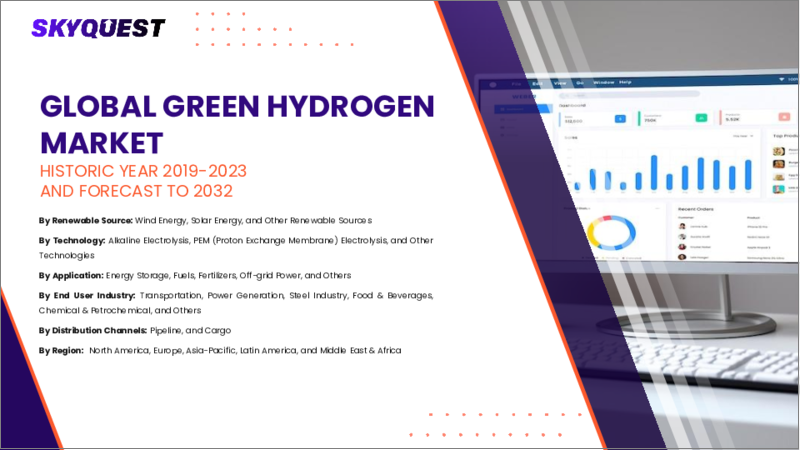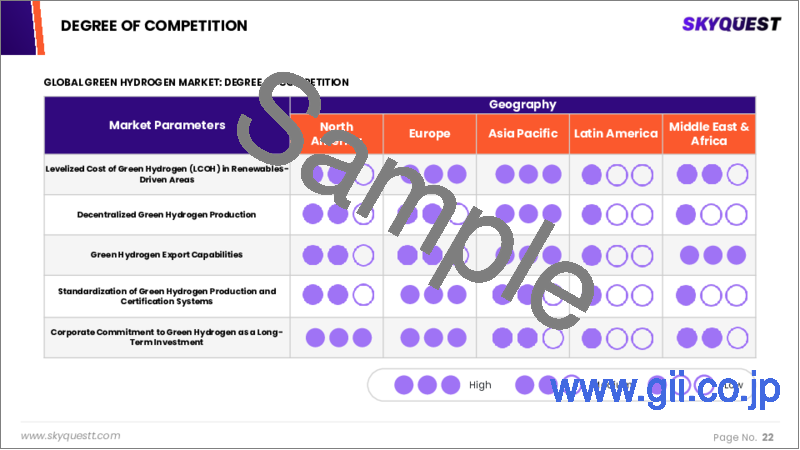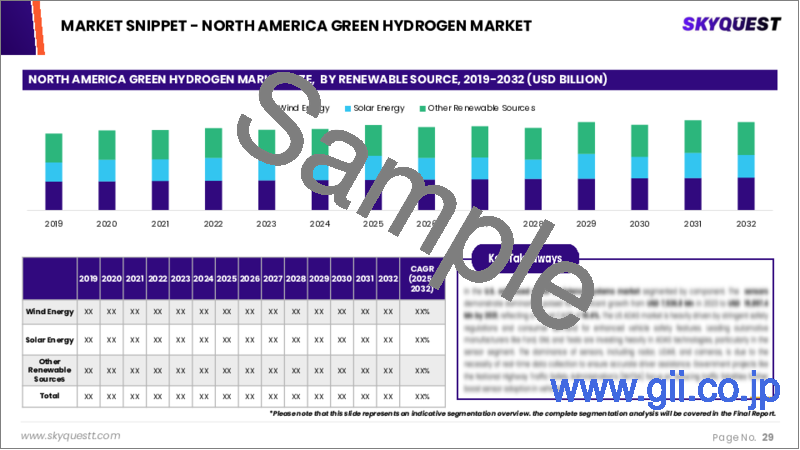|
|
市場調査レポート
商品コード
1610783
グリーン水素の市場規模、シェア、成長分析、技術別、供給源別、最終用途別、地域別 - 産業予測、2024年~2031年Green Hydrogen Market Size, Share, Growth Analysis, By Technology (Alkaline Electrolysis, PEM Electrolysis), By Source, By End-use, By Region -Industry Forecast 2024-2031 |
||||||
|
|||||||
| グリーン水素の市場規模、シェア、成長分析、技術別、供給源別、最終用途別、地域別 - 産業予測、2024年~2031年 |
|
出版日: 2024年12月09日
発行: SkyQuest
ページ情報: 英文 162 Pages
納期: 3~5営業日
|
全表示
- 概要
- 目次
グリーン水素の世界市場規模は、2022年に62億3,000万米ドルと評価され、2023年の86億9,000万米ドルから2031年には893億1,000万米ドルに成長し、予測期間(2024-2031年)のCAGRは39.5%で成長する見通しです。
グリーン水素市場は、持続可能性への注目の高まりとクリーンエネルギーに対する世界の需要の増加により、大きな成長を遂げようとしています。電解技術における主要な進歩や新しい電解槽のイントロダクションは、この分野の企業にとって新たなビジネスチャンスとなると思われます。再生可能エネルギーへのシフトが進行し、脱炭素化に向けて多額の投資が行われていることは、市場開拓をさらに促進すると予想されます。自動車排出ガス削減の推進に後押しされた水素自動車の人気上昇も、市場拡大に寄与すると思われます。先進国は、その豊富な資金力を背景に、この成長をリードする可能性が高いです。とはいえ、不十分なインフラ、代替エネルギーとの競合、変換効率の悪さ、生産コストの高さといった課題は、今後の市場の見通しを弱める可能性があります。
目次
イントロダクション
- 調査の目的
- 調査範囲
- 定義
調査手法
- 情報調達
- 二次データと一次データの方法
- 市場規模予測
- 市場の前提条件と制限
エグゼクティブサマリー
- 世界市場の見通し
- 供給と需要の動向分析
- セグメント別機会分析
市場力学と見通し
- 市場概要
- 市場規模
- 市場力学
- 促進要因と機会
- 抑制要因と課題
- ポーター分析と影響
- 競争企業間の敵対関係
- 代替品の脅威
- 買い手の交渉力
- 新規参入業者の脅威
- 供給企業の交渉力
主な市場の考察
- 重要成功要因
- 競合の程度
- 主な投資機会
- 市場エコシステム
- 市場の魅力指数(2023年)
- PESTEL分析
- マクロ経済指標
- バリューチェーン分析
- 価格分析
- 技術の進歩
- 規制情勢
- ケーススタディ
グリーン水素市場規模:技術別& CAGR(2024-2031)
- アルカリ電気分解
- PEM電気分解
グリーン水素市場規模:供給源別& CAGR(2024-2031)
- 風力エネルギー
- 太陽エネルギー
- その他
- 地熱
- 水力
- 風力と太陽のハイブリッド
グリーン水素市場規模:最終用途別& CAGR(2024-2031)
- モビリティ
- 化学薬品
- 電力
- グリッドインジェクション
- 産業
- その他
グリーン水素市場規模:地域別& CAGR(2024-2031)
- 北米
- 米国
- カナダ
- 欧州
- 英国
- ドイツ
- スペイン
- フランス
- イタリア
- その他欧州地域
- アジア太平洋地域
- 中国
- インド
- 日本
- 韓国
- その他アジア太平洋地域
- ラテンアメリカ
- ブラジル
- その他ラテンアメリカ地域
- 中東・アフリカ
- GCC諸国
- 南アフリカ
- その他中東・アフリカ
競合情報
- 上位5社の比較
- 主要企業の市場ポジショニング(2023年)
- 主な市場企業が採用した戦略
- 市場の最近の動向
- 企業の市場シェア分析(2023年)
- 主要企業の企業プロファイル
- 会社概要
- 製品ポートフォリオ分析
- セグメント別シェア分析
- 収益の前年比比較(2021-2023)
主要企業プロファイル
- Air Liquide
- Air Products Inc.
- Bloom Energy
- Cummins Inc.
- Engie
- Linde plc.
- Nel ASA
- Siemens Energy
- Toshiba Energy Systems & Solutions Corporation
- Uniper SE
- H&r olwerke schindler gmbh
- Wind to gas energy gmbh & co. Kg
- Sino-synergy hydrogen energy technology(jiaxing)co., ltd
- Iberdrola s.a
- Enel green power s.p.a
- Envision digital
- Hynamics(edf)
- Acwa power
- Green hydrogen systems
- The state atomic energy corporation rosatom
結論と推奨事項
Global Green Hydrogen Market size was valued at USD 6.23 Billion in 2022 and is poised to grow from USD 8.69 Billion in 2023 to USD 89.31 Billion by 2031, growing at a CAGR of 39.5% during the forecast period (2024-2031).
The green hydrogen market is set for significant growth driven by a heightened focus on sustainability and the increasing global demand for clean energy. Key advancements in electrolysis technologies and the introduction of new electrolyzers are poised to unlock fresh opportunities for companies in this sector. The ongoing shift towards renewable energy and substantial investments in decarbonization are further expected to enhance market development. The rising popularity of hydrogen-powered vehicles, fueled by a push for reduced vehicle emissions, will also contribute to market expansion. Developed nations are likely to lead this growth due to their substantial financial capabilities. Nevertheless, challenges such as inadequate infrastructure, competition from alternative energy sources, conversion inefficiencies, and high production costs may temper the market's outlook moving forward.
Top-down and bottom-up approaches were used to estimate and validate the size of the Global Green Hydrogen market and to estimate the size of various other dependent submarkets. The research methodology used to estimate the market size includes the following details: The key players in the market were identified through secondary research, and their market shares in the respective regions were determined through primary and secondary research. This entire procedure includes the study of the annual and financial reports of the top market players and extensive interviews for key insights from industry leaders such as CEOs, VPs, directors, and marketing executives. All percentage shares split, and breakdowns were determined using secondary sources and verified through Primary sources. All possible parameters that affect the markets covered in this research study have been accounted for, viewed in extensive detail, verified through primary research, and analyzed to get the final quantitative and qualitative data.
Global Green Hydrogen Market Segmental Analysis
Global Green Hydrogen Market is segmented by Technology, by Source, by End Use and by Region. Based on Technology, the market is segmented into Alkaline Electrolysis, PEM Electrolysis. Based on Source, the market is segmented into Wind Energy, Solar Energy, Others (geothermal, hydropower, and hybrid of wind & solar). Based on End Use, the market is segmented into Wind Energy, Solar Energy, Others (geothermal, hydropower, and hybrid of wind & solar). Based on region, the market is segmented into North America, Europe, Asia Pacific, Latin America and Middle East & and Africa.
Driver of the Global Green Hydrogen Market
The global green hydrogen market is primarily driven by significant advancements in electrolysis technologies, responding to the increasing demand for environmentally friendly hydrogen production. This push for sustainability has catalyzed innovations such as proton exchange membrane (PEM) and solid oxide electrolysis cells (SOECs), which enhance the efficiency and scalability of green hydrogen production. These technological improvements not only streamline the production process but also contribute to the broader expansion of the green hydrogen sector, aligning with global efforts to reduce carbon emissions and promote renewable energy sources. As a result, the growth of the industry is closely linked to these technological breakthroughs.
Restraints in the Global Green Hydrogen Market
One of the significant constraints facing the global green hydrogen market is the insufficient infrastructure necessary for its production and transportation. Currently, this infrastructure is in the early phases of development, which hinders the market's growth potential. Establishing a comprehensive global hydrogen network demands considerable investment and collaboration among governments, industries, and private investors. Achieving such coordinated efforts in the short term poses a substantial challenge, which ultimately dampens the demand for green hydrogen. As a result, the lack of robust infrastructure creates a barrier to widespread adoption and limits advancements in the green hydrogen sector.
Market Trends of the Global Green Hydrogen Market
The Global Green Hydrogen market is witnessing a significant trend towards hydrogen blending, where companies focus on integrating green hydrogen with natural gas to mitigate carbon footprints and enhance heating efficiency. This approach not only optimizes existing infrastructure but also provides a transitional pathway as the production of green hydrogen scales. By utilizing current gas systems, stakeholders can begin reducing greenhouse gas emissions while developing dedicated green hydrogen infrastructure. This strategic blending paves the way for broader adoption of green hydrogen solutions, thereby positioning companies favorably in the evolving energy landscape and supporting the global transition towards sustainable energy systems.
Table of Contents
Introduction
- Objectives of the Study
- Scope of the Report
- Definitions
Research Methodology
- Information Procurement
- Secondary & Primary Data Methods
- Market Size Estimation
- Market Assumptions & Limitations
Executive Summary
- Global Market Outlook
- Supply & Demand Trend Analysis
- Segmental Opportunity Analysis
Market Dynamics & Outlook
- Market Overview
- Market Size
- Market Dynamics
- Driver & Opportunities
- Restraints & Challenges
- Porters Analysis & Impact
- Competitive rivalry
- Threat of substitute
- Bargaining power of buyers
- Threat of new entrants
- Bargaining power of suppliers
Key Market Insights
- Key Success Factors
- Degree of Competition
- Top Investment Pockets
- Market Ecosystem
- Market Attractiveness Index, 2023
- PESTEL Analysis
- Macro-Economic Indicators
- Value Chain Analysis
- Pricing Analysis
- Technological Advancement
- Regulatory Landscape
- Case Studies
Global Green Hydrogen Market Size by Technology & CAGR (2024-2031)
- Alkaline Electrolysis
- PEM Electrolysis
Global Green Hydrogen Market Size by Source & CAGR (2024-2031)
- Wind Energy
- Solar Energy
- Others
- Geothermal
- Hydropower
- Hybrid of wind & solar
Global Green Hydrogen Market Size by End Use & CAGR (2024-2031)
- Mobility
- Chemical
- Power
- Grid Injection
- Industrial
- Others
Global Green Hydrogen Market Size by Region & CAGR (2024-2031)
- North America, (by Technology, by Source, by End Use)
- US
- Canada
- Europe, (by Technology, by Source, by End Use)
- UK
- Germany
- Spain
- France
- Italy
- Rest of Europe
- Asia-Pacific, (by Technology, by Source, by End Use)
- China
- India
- Japan
- South Korea
- Rest of Asia Pacific
- Latin America, (by Technology, by Source, by End Use)
- Brazil
- Rest of Latin America
- Middle East & Africa, (by Technology, by Source, by End Use)
- GCC Countries
- South Africa
- Rest of Middle East & Africa
Competitive Intelligence
- Top 5 Player Comparison
- Market Positioning of Key Players, 2023
- Strategies Adopted by Key Market Players
- Recent Developments in the Market
- Company Market Share Analysis, 2023
- Company Profiles of All Key Players
- Company Details
- Product Portfolio Analysis
- Company's Segmental Share Analysis
- Revenue Y-O-Y Comparison (2021-2023)
Key Company Profiles
- Air Liquide
- Company Overview
- Business Segment Overview
- Financial Updates
- Key Developments
- Air Products Inc.
- Company Overview
- Business Segment Overview
- Financial Updates
- Key Developments
- Bloom Energy
- Company Overview
- Business Segment Overview
- Financial Updates
- Key Developments
- Cummins Inc.
- Company Overview
- Business Segment Overview
- Financial Updates
- Key Developments
- Engie
- Company Overview
- Business Segment Overview
- Financial Updates
- Key Developments
- Linde plc.
- Company Overview
- Business Segment Overview
- Financial Updates
- Key Developments
- Nel ASA
- Company Overview
- Business Segment Overview
- Financial Updates
- Key Developments
- Siemens Energy
- Company Overview
- Business Segment Overview
- Financial Updates
- Key Developments
- Toshiba Energy Systems & Solutions Corporation
- Company Overview
- Business Segment Overview
- Financial Updates
- Key Developments
- Uniper SE
- Company Overview
- Business Segment Overview
- Financial Updates
- Key Developments
- H&r olwerke schindler gmbh
- Company Overview
- Business Segment Overview
- Financial Updates
- Key Developments
- Wind to gas energy gmbh & co. Kg
- Company Overview
- Business Segment Overview
- Financial Updates
- Key Developments
- Sino-synergy hydrogen energy technology (jiaxing) co., ltd
- Company Overview
- Business Segment Overview
- Financial Updates
- Key Developments
- Iberdrola s.a
- Company Overview
- Business Segment Overview
- Financial Updates
- Key Developments
- Enel green power s.p.a
- Company Overview
- Business Segment Overview
- Financial Updates
- Key Developments
- Envision digital
- Company Overview
- Business Segment Overview
- Financial Updates
- Key Developments
- Hynamics (edf)
- Company Overview
- Business Segment Overview
- Financial Updates
- Key Developments
- Acwa power
- Company Overview
- Business Segment Overview
- Financial Updates
- Key Developments
- Green hydrogen systems
- Company Overview
- Business Segment Overview
- Financial Updates
- Key Developments
- The state atomic energy corporation rosatom
- Company Overview
- Business Segment Overview
- Financial Updates
- Key Developments






